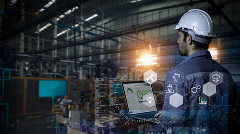How Color Psychology Can Improve Workplace Safety

Whether you realize it or not, color affects your behavior every day. Simply stopping your vehicle when you see a red light is an example of how your brain responds to color cues. That’s because color, when used as part of a repetitive, standardized system, becomes a part of your automatic, intuitive response.
It’s scientifically proven. Numerous studies over the years illustrate the impact of color:- Blue streetlights introduced in Glasgow, Scotland, and Japan decreased the number of crimes in the area
- Color increases brand recognition by up to 80%, according to a study at the University of Loyola
- An insurance company received customer payments 14 days earlier after using color to highlight key information on its invoices
- An experiment showed that in a room with red light, the elapsed time was overestimated, but in a room with green or blue light, the elapsed time was underestimated
- Workers lifting black boxes thought they were heavier than the same boxes painted green
How the Brain Processes Color
When we see a color, we react. Color can increase memory, engage and increase participation, and attract attention.The use of color relies on the principle of cognitive consistency (humans seek consistency in beliefs and attitudes in any situation). Humans base their decisions on the outcome of past events, which is why you continue to make the quick decision to go when you see a green light. When there isn’t a consistency to follow, humans tend to feel more uncomfortable and take a longer time to make decisions, also known as cognitive dissonance.
It stands to reason that the more color and consistency is built into our worlds, the more efficient actions will become.
Benefits of Color in the Workplace
Using colored signs and labels can go a long way for your workplace and your employees. It can help improve:
-
Safety:
A consistent color standard in your workplace helps employees quickly recognize and respond with the correct action. This is an essential element to establishing and maintaining a safe workplace. When an employee sees a red danger sign, for example, immediately they know to pay attention and take steps necessary to stay safe. Using safety signs with standardized colors helps to speed up recognition and response time to workplace hazards. -
Productivity:
Visual cues not only improve safety but help to improve productivity. That’s because using color-coding and effective labeling on inventory, processes and general facility identification can help reinforce employee training and guide workers to complete their tasks more quickly. In addition, safe state, equipment identification and safety signs all help to keep processes running smoothly so you have less downtime. -
Cost Savings:
When you are able to keep your workplace safer and more productive due to colorful and consistent workplace visuals, you end up saving time and money. That’s because training is reduced by visually reinforcing processes and steps, equipment is kept in proper working conditions and tasks are completed more safely and efficiently.
Applying Color Psychology to the Workplace
Now that you better understand the psychology behind color, you may be wondering what it means for your workplace. The use of color visuals in the workplace can make your workers efficient and safe by:- Speeding Up Visual Search
- Improving Recognition
- Emphasizes Information
- Shows Associations
- Transmits Important Messages
Shop our top product recommendations to get you started:
Article Source: Brady









